Assembly Instructions The Renard SS24: Difference between revisions
m (→Board Assembly) |
m (→Board Assembly) |
||
| (One intermediate revision by the same user not shown) | |||
| Line 63: | Line 63: | ||
|- | |- | ||
| | | | ||
* '''12''' - Install the 330 ohm resistor network RN1 (PN# | * '''12''' - Install the 330 ohm resistor network RN1 (PN# 652-4606X-AP1-331LF). The resistor network should have a dot on it to indicate pin 1. Insert pin 1 of the resistor network into the square solder pad (to the left). | ||
|| [[Image:Wiki - Renard SS24 Assembly Step12.jpg | 200px]] | || [[Image:Wiki - Renard SS24 Assembly Step12.jpg | 200px]] | ||
|- | |- | ||
| Line 254: | Line 254: | ||
|align="left"|Resistor, Carbon Film 180 ohms 1/4W 5% | |align="left"|Resistor, Carbon Film 180 ohms 1/4W 5% | ||
|- | |- | ||
| | |652-4606X-AP1-331LF ||1||RN1 | ||
|align="left"|Resistor Network, 6 pin, 330ohms 2% | |align="left"|Resistor Network, 6 pin, 330ohms 2% | ||
|- | |- | ||
Latest revision as of 22:56, 28 December 2020
Board Assembly
- The following sequence of steps is by no means the only way to assemble the Renard SS24. It is simply a suggested order of events to achieve the desired goal.
- NOTE: The part numbers referenced in the following instructions are those taken from the Renard SS24 BOM.
|

|
|
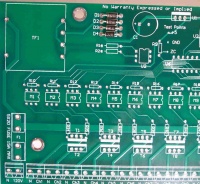
|
|
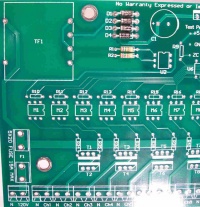
|
|

|
|
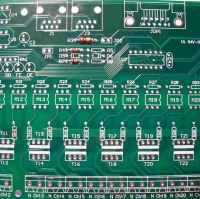
|
|
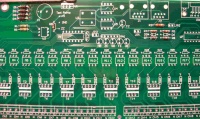
|
|
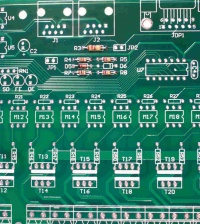
|
|
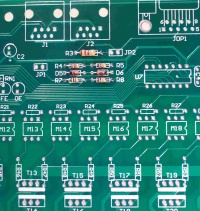
|
|

|
|

|
|
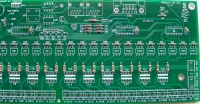
|
| |
|
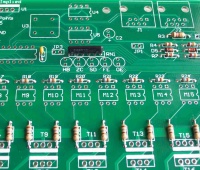
|
|
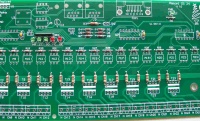
|
|
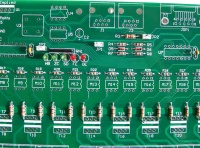
|
|
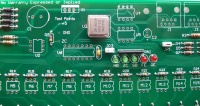
|
|
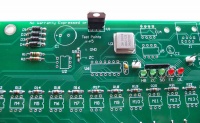
|
|
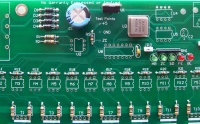
|
|
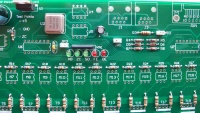
|
|

|
| |
|
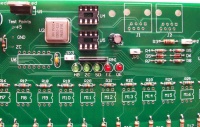
|
|
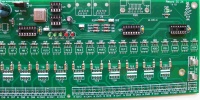
|
|

|
|

|
|
|
|

|
|
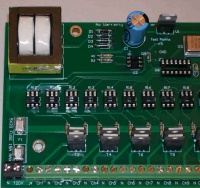
|
|
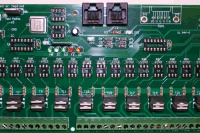
|
|
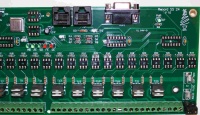
|
| |
| |
|
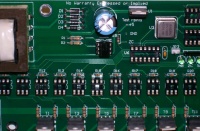
|
|

|
|
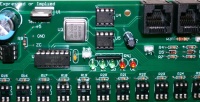
|
|

|
|
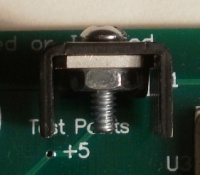
|
|
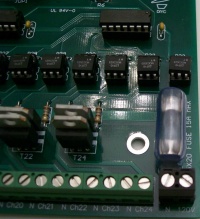
|
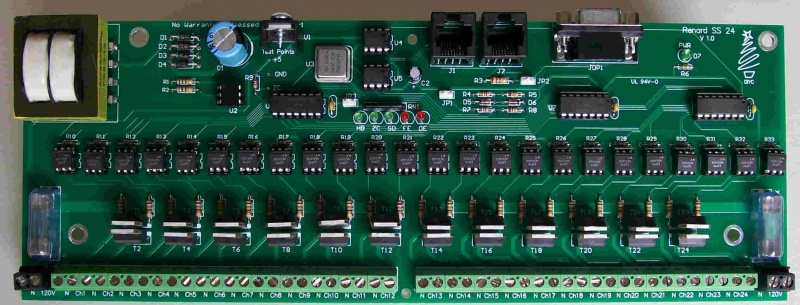
Triac Heat Sink
- A simple heat sink can be fabricated from flat aluminum (1/16” thick) available at your local home improvement store. The heat sinks most commonly included in the Kits and group buys are made in this fashion. You can use a different width flat bar if desired, but you have to keep with the 1/16" thickness. A template for the hole pattern can be found here. The overall dimensions are shown here. The triac listed in the BOM has an isolated tab, so no isolators are needed.
- A small amount of heat transfer compound should be applied between the heat sink and the tab of the triacs. You can use the same compounds that are used on computer CPU chips and their heat sinks. If you don't have any available locally, you can always use something like Mouser PN# 532-249.
Parts Listing (BOM)
IMPORTANT BOM INFORMATION:
Mouser part numbers are listed (unless otherwise noted) as a means of simplifying the listing. Mouser is not the only place to get these parts, they are used as the reference since they tend to have all the parts needed to complete the project. However, the parts can be procured from any electronics parts source that you prefer.
In the event that any of the following parts are not in stock at Mouser when you decide to order them, you can check the Part Substitutions wiki page and see if there any suggestions for alternative parts.
| PART NUMBER (Mouser PN# unless noted) |
QTY | REF | NOMENCLATURE |
|---|---|---|---|
| 511-LF50CV | 1 | U1 | 5 VDC Voltage Regulator |
| 532-577102B00 | 1 | Heatsink for Voltage Regulator | |
| 782-H11AA1 | 1 | U2 | Optocoupler, Bi-Directional Input |
| 815-ACH-18.432-EK | 1 | U3 | Crystal Clock Oscillator, 18.432 MHz |
| 595-SN65LBC176P | 2 | U4, U5 | Differential Bus Transceivers |
| 571-1-2199298-2 | 2 | IC Socket, 8 pin (for U4 & U5) | |
| 579-PIC16F688-I/P | 3 | U6-U8 | PIC Microcontroller |
| 571-1-2199298-3 | 3 | IC Socket, 14 pin (for U6-U8) | |
| 859-MOC3023 | 24 | M1-M24 | Optoisolator, Triac Driver |
| 571-1-2199298-1 | 25 | IC Socket, 6 pin (for U2, M1-M24) | |
| 511-BTA06-600CW | 24 | T1-T24 | Triac, 6A 600V |
| 291-750-RC | 2 | R1, R2 | Resistor, Carbon Film 750 ohms 1/4W 5% |
| 291-120-RC | 1 | R3 | Resistor, Carbon Film 120 ohms 1/4W 5% |
| 299-1K-RC | 2 | R4, R7 | Resistor, Carbon Film 1K ohms 1/8W 5% |
| 299-27K-RC | 3 | R5, R8, R9 | Resistor, Carbon Film 27K ohms 1/8W 5% |
| 299-680-RC | 25 | R6, R10-R33 | Resistor, Carbon Film 680 ohms 1/8W 5% |
| 291-180-RC | 24 | R34-R57 | Resistor, Carbon Film 180 ohms 1/4W 5% |
| 652-4606X-AP1-331LF | 1 | RN1 | Resistor Network, 6 pin, 330ohms 2% |
| 511-1N5817 | 4 | D1-D4 | Diode |
| 78-1N5239B | 1 | D6 | Diode, Zener 9.1V .5W |
| 78-1N5229B | 1 | D5 | Diode, Zener 4.3V .5W |
| 604-WP710A10IT | 2 | FE, OE | LED, 3mm Red |
| 604-WP710A10GT | 4 | PWR, HB, ZC, SD | LED, 3mm Green |
| 140-REA222M1CBK1320P | 1 | C1 | Radial Electrolytic Capacitor 16V 2200uF 20% |
| 140-REA470M1CBK0511P | 1 | C2 | Radial Electrolytic Capacitor 16V 47uF 20% |
| 80-C322C104K5R | 3 | C3-C5 | Capacitor, Radial Ceramic 50V 0.1uF |
| 571-2828372 | 24 | Channel Terminals | Terminal Block, 2 Pos 5.08 mm |
| 571-7969492 | 2 | Power Terminals | Terminal Block, 2 Pos 5.08 mm |
| 152-3409 | 1 | JDP1 | D-Sub Connectors, Right Angle DE9 |
| 571-5556416-1 | 2 | J1, J2 | Jack, Modular RJ45 PCB Mount Top Entry |
| 538-22-03-2021 | 3 | JP1-JP3 | Header, 2 Pin |
| 806-SX1100-B | 3 | Shunt | |
| 504-BK/GMA-10-R | 2 | F1, F2 | Fuse, Fast Acting 10A |
| 534-3517 | 4 | Holder, Fuse Clip PCB mount 5mm | |
| 534-3527C | 2 | Cover, Fuse | |
| 838-3FS-312 | 1 | TF1 | Power Transformers 12.6VCT@.2A 6.3V@.4A Single Primary |
If you are planning on ordering from Mouser Electronics you can use this Shared Project to make it easier to order the parts.
Hardcopy Instructions
